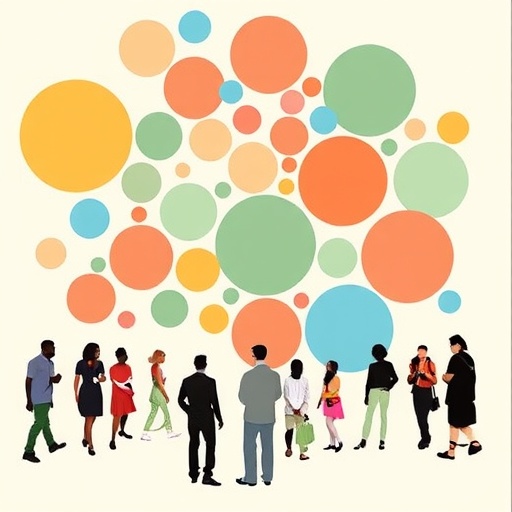In today’s increasingly interconnected world, the phenomenon of social bubbles—the tendency of individuals to surround themselves with people who share similar characteristics—remains remarkably prevalent. Recent research spearheaded by Kasimir Dederichs and his colleagues delves deeply into this behavioral pattern, utilizing sophisticated survey experiments conducted in the Netherlands to uncover the underlying drivers and consequences of ingroup preferences in social settings. Their study, published in the esteemed journal PNAS Nexus, exposes how people’s decisions about where to live and which social organizations to join are intricately shaped by an implicit preference for interacting with others who mirror their own ethnicity, age, and educational strata.
Unlike traditional survey methods that rely on self-reported tolerance or acceptance of diversity—which are notoriously susceptible to social desirability bias—the methodology applied here involves presenting respondents with concrete choices between neighborhoods and civic organizations based on varying demographic compositions alongside other realistic factors such as financial cost, travel time, and perceived friendliness. This choice-based approach compels participants to reveal their preferences in environments that more closely mimic real-life decision-making contexts. The robustness of this experimental design lends considerable weight to the findings, highlighting how ingrained and regulated these preferences can be.
One of the most striking insights from the study is the consistent pattern of so-called ingroup preference: people overwhelmingly opt for neighborhood and social club compositions dominated by individuals who share their ethnic background, belong to a similar age group, or possess a comparable level of educational attainment. This suggests that social homophily—the human predilection for bonding with similar others—extends well beyond casual interactions and significantly affects major life decisions. The implications of this pattern reverberate across social cohesion, urban planning, and integration policies.
Interestingly, the study identifies a noteworthy exception regarding education levels. Individuals without a college degree expressed a surprisingly high tolerance for interacting with others who possess higher educational qualifications. This nuance provides a glimpse into the complexities of social identity, hinting that educational disparities might not create as rigid a boundary as ethnicity or age. Such findings open avenues for targeted interventions designed to bridge educational divides in community formation.
Further quantification of these ingroup preferences reveals compelling trade-offs that respondents are willing to make. For example, younger individuals under the age of 50 were willing to extend their travel time by approximately five minutes to engage in social clubs with fewer older members. Similarly, Dutch respondents without a migration background demonstrated a readiness to incur an additional ten minutes when running errands if it meant living in neighborhoods devoid of residents with Turkish or Moroccan backgrounds. These trade-offs underscore how deeply embedded biases operate beneath the surface of everyday life choices.
Perhaps most revealing is the feedback loop identified between exposure and preference. Those respondents who currently live and socialize predominantly within homogeneous groups exhibited stronger ingroup preferences, indicating that limited intergroup contact reinforces social segregation. Conversely, individuals with more frequent exposure to diverse social groups displayed less rigid boundaries, illustrating the potential transformative power of intergroup contact in reducing social fragmentation.
From a methodological standpoint, the researchers’ use of large-scale choice experiments represents a significant advancement in the empirical study of social segregation and ingroup favoritism. By situating participants in scenarios requiring realistic trade-offs, the study avoids the pitfalls of purely attitudinal surveys and provides a more accurate gauge of social behavior. This methodological innovation sets a precedent for future research aiming to unravel the cognitive and social mechanisms of segregation.
The implications of these findings resonate widely within social policy circles. The linkage between personal preferences and broader patterns of segregation suggests that policy interventions must transcend surface-level tolerance campaigns and address structural environments and incentives. Urban planning that inadvertently reinforces segregated living, for instance, may perpetuate a vicious cycle of social isolation and ingroup preference, challenging integration efforts.
Moreover, the intersection of ethnicity, age, and education as axes of social division highlights the multifaceted nature of segregation. Comprehensive strategies to promote social mixing must therefore be nuanced, recognizing the distinct barriers and motivators within each dimension. The role of civic organizations as potential arenas for positive intergroup contact emerges as especially salient, offering an avenue through which social cohesion can be fostered beyond residential neighborhoods.
The research also poses critical questions about the psychological underpinnings fueling these preferences. While evolutionary psychology offers theories on ingroup favoritism as a survival mechanism, contemporary social environments complicate these dynamics. The willingness to sacrifice convenience to maintain homogeneous social milieus hints at deeply rooted comfort zones and perceived social threats that transcend rational calculation.
As societies grapple with demographic shifts, migration, and increasing cultural pluralism, understanding the mechanisms of social bubble formation is vital. The findings by Dederichs and colleagues provide a cautionary tale about the self-reinforcing nature of segregation, suggesting that without deliberate, sustained intervention, social divides may harden, undermining social trust and solidarity.
In conclusion, this insightful study advances our understanding of how subtle social preferences influence fundamental life choices and contribute to the persistence of segregation. By revealing the intricate patterns of ingroup favoritism across multiple social dimensions, it lays the groundwork for innovative policies and community initiatives aimed at fostering genuine social integration. Breaking free from entrenched social bubbles is not an easy task, but the path forward becomes clearer with empirical guidance illuminating the choices and trade-offs shaping our social landscapes.
Subject of Research: Social segregation, ingroup preferences, and intergroup contact in neighborhoods and civic organizations.
Article Title: Ingroup preferences, segregation, and intergroup contact in neighborhoods and civic organizations
News Publication Date: 2-Sep-2025
Keywords: Social sciences




